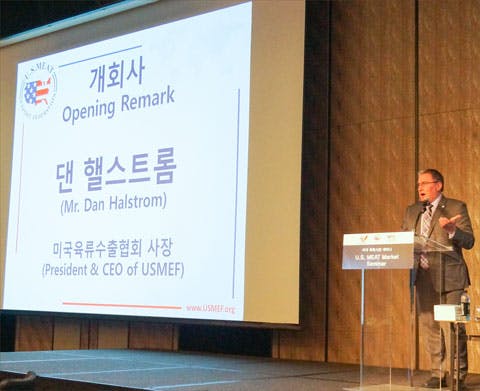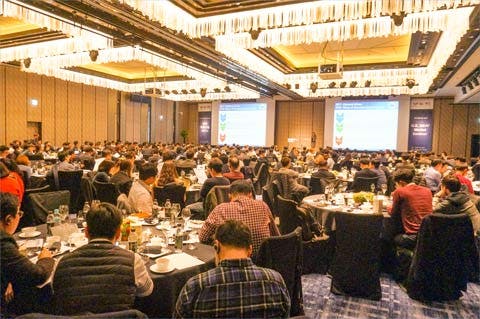U.S. Meat Market Seminar Updates Korean Buyers on U.S. Pork, Beef
Expressing appreciation for the South Korean food industry’s growing demand for U.S. pork and beef, USMEF recently hosted more than 300 traders, distributors, foodservice operators and retailers at a U.S. Meat Market Seminar in Seoul. Funded by the USDA Market Access Program, the Pork Checkoff and the Beef Checkoff Program, the seminar included an overview of the U.S. pork and beef industries, updates on the global red meat market and information on South Korea’s domestic production and demand.

USMEF President and CEO Dan Halstrom addresses attendees at the U.S. Meat Market Seminar in Seoul
Jihae Yang, USMEF director in Korea, said the seminar was intended to help Korean business owners and managers prepare their respective business plans.
“The seminar was really an objective look at the worldwide red meat market and an overview of what buyers can expect in the coming months,” explained Yang. “The speakers did a great job of laying out the situation for pork and beef, and attendees expressed gratitude for information like the Korean consumer trend outlook, which paints a picture of what people in Korea are interested in and food dishes that are increasingly popular.”

USMEF hosted more than 300 Korean traders, distributors, foodservice operators and retailers at the U.S. Meat Market Seminar
Before welcoming remarks by Ron Verdonk, agricultural minister-counselor at the U.S. Embassy in Seoul, USMEF President and CEO Dan Halstrom opened the seminar with an update on U.S. pork and beef exports to Korea, noting that U.S. beef exports sharply increased in 2017, reaching 184,152 metric tons. This topped imports from Australia, allowing U.S. beef to regain its No.1 status in the Korean market for the first time in 14 years.

USMEF Economist Erin Borror provided an overview of the global meat market, including insights on production, pricing and trade
Halstrom also shared good news about U.S. pork exports to Korea, which achieved a year-over-year increase of about 30 percent in 2017.
“We would really like to thank people in the Korean industry for the long-term partnership we’ve enjoyed and let them know USMEF will keep working to further develop our programs to move more U.S. pork and beef into the country,” said Halstrom. “Korea is an important market and we want to continue to engage the trade and expand the business.”
USMEF Economist Erin Borror, along with HyungWoo Lee, head of the Livestock Market Outlook Division of Korea Rural Economic Institute (KREI), and Duck Hwan Yoon, senior executive of Macromill Embrain, provided separate presentations.
Borror updated attendees on global pork and beef production, pricing and trade. She also addressed additional factors that could affect the overall global meat market, and the Korean market in particular.
Yoon emphasized that the meat industry should play close attention to consumer desires and trends. He also discussed how Korean consumers have changed and what the key consumer trends are expected to be in 2018.
Looking at Korea’s domestic red meat market, Lee reported that the number of Hanwoo and dairy cattle in 2018 will increase 1.3 percent to 3.03 million head, while domestic beef cattle production will decrease slightly.
He added that Korea’s calf production in 2018 will move higher after dropping slightly in 2017, and semen sales in 2017 increased 6.6 percent compared to 2016.
On the pork side, Lee said Korea’s sow numbers have reached 1.01 to 1.03 million head, the highest level since 2010. Total hog inventory is projected to increase to around 10.7 to 10.9 million head through 2018. Pork production is expected to reach 445,000 metric tons in the first half of the year, which is slightly higher than the same period in 2017.
After the seminar, USMEF served U.S. wagyu beef and U.S. Berkshire pork at a dinner for attendees.
